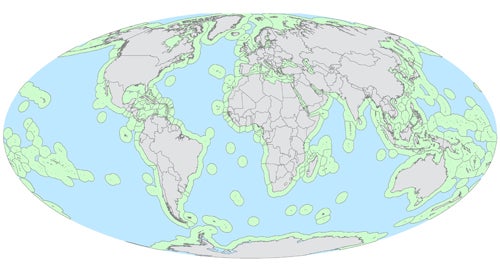
Could Closing the High Seas to Fishing Save Migratory Fish?

You have probably heard that wild fish are in peril around the world, and that in some places their populations are in precipitous decline. That is particularly true on the high seas, or international waters. Operating as a massive unregulated global commons, where any nation can take as much as it wants, the high seas are experiencing a latter-day “tragedy of the commons,” with the race for fish depleting stocks of tuna, billfish and other high-value migratory species. A new paper, written by Christopher Costello, a professor of resource economics at UC Santa Barbara’s Bren School of Environmental Science & Management, and Crow White, an assistant professor in the biological sciences department at Cal Poly San Luis Obispo and a former Bren School postdoctoral researcher, suggests a bold approach to reversing this decline: close the high seas to fishing.
The paper appears today in the open access journal PLOS Biology.
Sound like a radical notion? Not according to White and Costello, who found that such a policy could actually provide a triple-bottom-line benefit, increasing not only global stocks of high-value species, but also fisheries harvests and profits from them. The idea is that closing the high seas to fishing would allow fish populations to rebuild, and because the fish migrate, it would also generate a “spillover effect” as some fish from protected international waters find their way into the exclusive economic zones (EEZs) of each nation, where they could be harvested.
Currently, the world’s oceans are governed as a system of more than 150 EEZs occupying about 42% of the ocean, and one large high-seas commons comprising the remaining 58%, which is essentially open-access to all nations. Many high-value fish species migrate across these large oceanic regions. Some nations have catch limits on such fish in their own EEZs, but with essentially no catch limits on the high seas, migratory fish are systematically overfished, with the result that their numbers continue to decline. Over the decades, hundreds of attempts have been made to create international agreements to coordinate fishing across EEZs and the high seas. Nearly all have failed, and today, migratory species on the high seas pose perhaps the greatest global challenge to sustainable fisheries management.
The researchers addressed the problem by developing a computer simulation model of global ocean fisheries and using it to examine a number of management scenarios, including a complete closure of fishing on the high seas. The model has a bio-geographic component that tracks the migration and reproduction of fish stocks in different areas, and a socio-economic component that quantifies the fishing pressure or activity, catch, and profits by each fishing nation under various polices.
They found that closing the high seas could more than double both populations of key species and fisheries profit levels, while increasing fisheries yields by more than 30%. As an alternative to a high seas closure, the authors also examined a policy that would extend the world’s EEZs beyond the current 200-nautical-mile limit. In addition, they found that while that solution could benefit some fisheries, a complete closure of the high seas would provide superior fishery and conservation outcomes.
“From a policy perspective, the results are incredibly important because they indicate a win-win-win —food, profit, conservation — scenario from closing the high seas,” said lead author White.
“Further, even though our main focus was on the profitability of fisheries, this policy would represent possibly the largest conservation benefit ever enacted in the world’s oceans,” said co-author Costello, a resource and environmental economist at the Bren School. “We were pretty shocked. We definitely did not set out thinking a complete closure could be such an all-around beneficial policy.”
The study makes a significant scientific contribution to an important, timely, and highly policy-relevant debate. To date, marine protected areas (MPAs) that ban or regulate fishing are largely located within EEZs. Only a few are located on the high seas, and they are too small to protect most migratory stocks. A complete closure of the high seas had not been proposed previously. Still, further research is needed before such a bold proposal could be put in to practice.
“We hope this can be a starting point for further analysis and debate about the ecological and economic implications and political feasibility of a high seas closure,” said White.
Issues to be addressed in more detail include the political acceptance of what will likely be highly varied impacts across different fisheries and nations. Also, the current legal instrument for high seas governance, the United Nations Convention on the Law of the Sea, would need to be reconfigured to include a high seas closure, and the methods and cost of enforcement would need to be determined and integrated into the closure’s logistical operation and economic performance.
“This is bold idea, and perhaps the only way to eliminate the Tragedy of the Commons that is unfolding in much of the ocean,” said Boris Worm, a marine research ecologist and associate professor at Dalhousie University in Nova Scotia. “The careful analysis presented in this paper supports this view, and is bolstered by more local ‘experiments’ where open access was eliminated and benefits arose quickly – both for fish and fishermen.”



